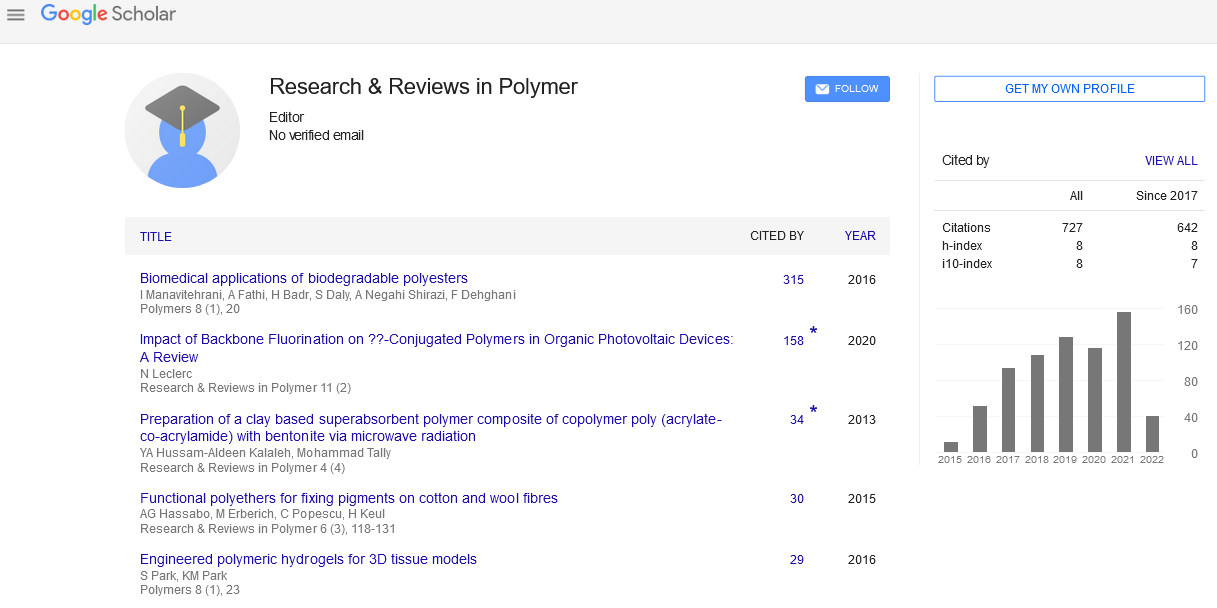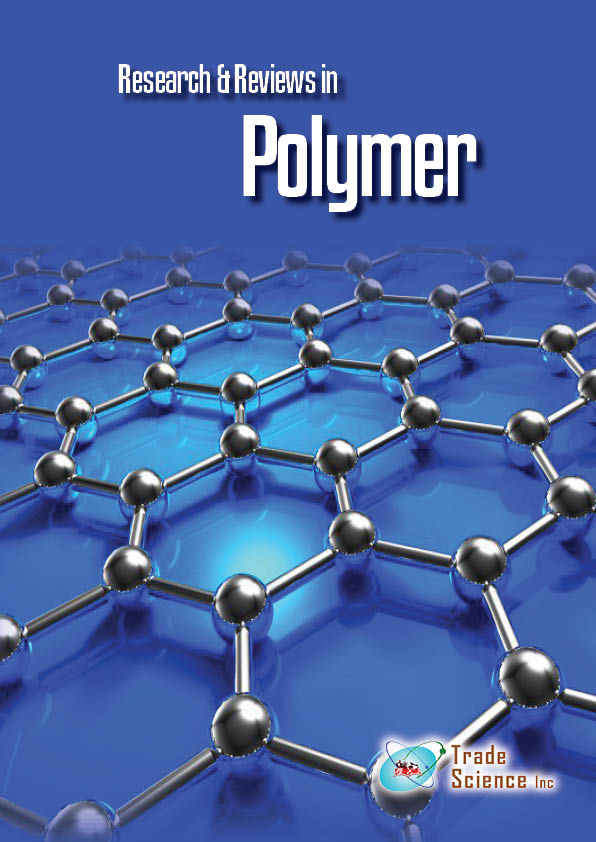Editorial
, Volume: 7( 4)Pyridine-Containing Ionically Conducting Polymers
- *Correspondence:
- Yeong-Soon Gal , Professor of Chemistry, Kyungil University, South Korea, Tel: +82 53-600-5487; E-mail: ysgal@kiu.kr
Received: November 22, 2016; Accepted: November 23, 2016; Published: November 27, 2016
Citation: Gal YS. Pyridine-Containing Ionically Conducting Polymers. Res Rev Polym. 2016;7(4):e101.
Abstract
Ionically conducting polymers are of great interest because of their extensive conjugation and ionic nature. These materials have potentials as materials for mixed ionic and electronic conductivity, energy storage devices, and permselective membrane. Blumstein’s group (University of Massachusetts) firstly synthesized interesting ionic conjugated polymers via the non-catalyst polymerization of ethynylpyridines using bromine, sulfuric acid, or alkyl halides. This polymerization method can originally prevent the contamination of polymer sample by the catalyst or initiator used during process because this polymerization do not need any additional initiator or catalyst. These polymers contain pyridinium ring substituents associated with halides, methane sulfonate, or tosylate counterions. The pyridine-based conjugated polyelectrolytes have been used as material candidates for the development of low-cost optoelectronic applications such as plastic electronic devices and biosensors.
Keywords
Polyelectrolytes; Ethynylpyridine; Polymerization; Cationic
Organic polyelectrolytes are based on C-C chains and contain in-chain, or more characteristically pendant, charged groups, and encompasses some very useful advanced materials. Since polyelectrolytes are important biopolymers of the living cell, the synthetic polyelectrolytes have been used as model to aid elucidation of polyelectrolyte functions in their native environment in the living cell. During the past four decades, the synthetic polyelectrolytes have been and continue to be active area of medicine, pharmacy, and biology, which have been mainly derived from their molecular self-organization phenomena in relevance to bio macromolecular systems and to nanoscopic molecular architecture as a basis of material science.
Conjugated polyelectrolytes are charged conjugated macromolecules with a large number of ionizable or ionic groups, which are at the forefront of developments in high technology. Such linear conjugated polyelectrolytes as poly(propiolic salt)s, poly(propargyltriphenylphosphonium bromide), poly(dipropargylammonium bromide), poly(propargylpyridinium bromide) had been reported. The anionic radical salts of TCNQ with poly(vinyl- and ethynylpyridines) was firstly reported in 1978. Poly(ethynylpyridinium salt)s were easily prepared by the refluxing of ethynylpyridine and methyl iodide/ethyl iodide in acetonitrile for 30 min. Subramanyam et al. [1] reported that the quaternized monomeric salts obtained from the first quaternization reaction of ethynylpyridines by halogens or alkyl halides undergo rapid, spontaneous polymerization yielding extensive conjugated polyelectrolytes.
Choi et al. [2] reported the various functional conjugated polyelectrolytes via the non-catalyst polymerization of ethynylpyridines using functional alkyl or carbonyl halides. Self-dopable conjugated polymers such as poly(2-ethynylpyridinium-N-benzoylsulfonate) and poly(2-ethynyl-N-(4-sulfobutyl) pyridinium betaine) were synthesized via the non-catalyst polymerization of 2-ethynylpyrodine using 2-sulfobenzoic acid cyclic anhydride and 1,4-butanesultone, respectively. The majority of ionic polymers consist of an anionic polymer and a small cationic counter ion. However, the pyridine-based polyelectrolytes conversely consist of a small anion and a polymeric cation.
These pyridine-based conjugated polyelectrolytes have been used as material candidates for the fabrication of ultrathin amphiphilic films, third-order nonlinear optical susceptibility, organic electroluminescent devices, nanostructured cationic polyacetylene-silica hybrids, dye-sensitized photochemical cell, SERS (surface-enhanced Raman spectroscopy) active π-conjugated polymer-Ag nanocomposites, and UV-eroding conductive patterns.
Gal et al. [3] reported that poly(2-ethynylpyridinium bromide) with N-propargyl side chains was highly stable, even under ambient air conditions. This material therefore has great potential as a candidate materials for the low-cost mass production of high-performance, programmable unipolar write-once-read-many-times (WORM) memory devices with very low power consumption [4]. Zhou et al. [5] found that the addition of some anions to the DMF or DMSO solution of poly(propargylpyridinium bromide) leads to the fluorescence enhancements up to 25 times. Recently, highly efficient inverted polymer: fullerene solar cells have been successfully developed with a power conversion efficiency of over 10%. The poly(N-dodecyl-2-ethynylpyridinium bromide) was used as an interfacial dipole layer [6].
References
- Subramanyam S, Blumstein A. Conjugated ionic polyacetylenes, 2?. A new polymerization method for substituted acetylenes. Makromol. Chem Rapid Commun. 1991;12:23-30.
- Choi SK, Gal YS, Jin SH, et al. Poly(1,6-heptadiyne)-based materials by metathesis polymerization. Chem Rev. 2000;100(4):1645-82.
- Gal YS, Jin SH, Park JW, et al. Synthesis and characterization of an ionic conjugated polymer: Poly(2-ethynyl-N-(2-thiophenecarbonyl) pyridinium chloride). J PolymSci Part A: Polym Chem. 2009;47(22):6153-62.
- Zhou C, Gao Y, Chen D. Investigation of pyridine/propargyl bromide reaction and strong fluorescence enhancements of the resultant poly(propargylpyridinium bromide). J PhysChem B. 2012;116(37):11552-9.
- Ko YG, Kwon W, Kim DM. Programmable nonvolatile electrical memory characteristics of an ionic conjugated polymer. Polym Chem. 2012;3:2028.
- Nam S, Seo J, Han H, et al. >10% Efficiency polymer:fullerene solar cells with polyacetylene-based polyelectrolyte interlayers. Adv Mater Interfaces 2016; 3(7): 1600415.

